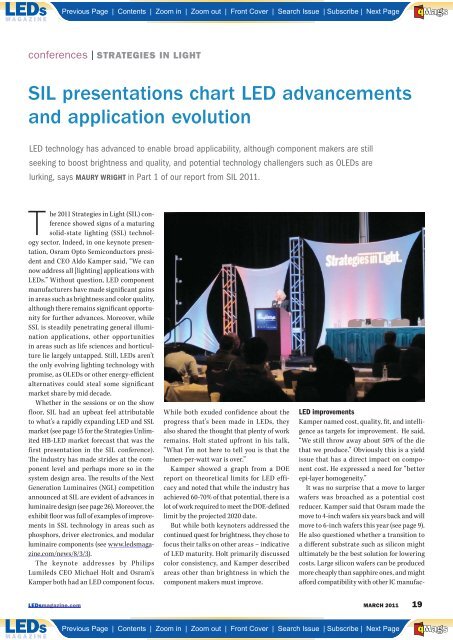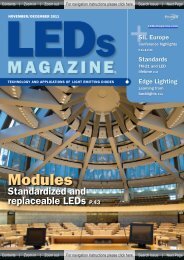Luminaires
Luminaires
Luminaires
- No tags were found...
You also want an ePaper? Increase the reach of your titles
YUMPU automatically turns print PDFs into web optimized ePapers that Google loves.
Previous Page | Contents | Zoom in | Zoom out | Front Cover | Search Issue | Subscribe | Next PageABE FMaGSconferences | STRATEGIES IN LIGHTSIL presentations chart LED advancementsand application evolutionLED technology has advanced to enable broad applicability, although component makers are stillseeking to boost brightness and quality, and potential technology challengers such as OLEDs arelurking, says MAURY WRIGHT in Part 1 of our report from SIL 2011.The 2011 Strategies in Light (SIL) conferenceshowed signs of a maturingsolid-state lighting (SSL) technologysector. Indeed, in one keynote presentation,Osram Opto Semiconductors presidentand CEO Aldo Kamper said, “We cannow address all [lighting] applications withLEDs.” Without question, LED componentmanufacturers have made significant gainsin areas such as brightness and color quality,although there remains significant opportunityfor further advances. Moreover, whileSSL is steadily penetrating general illuminationapplications, other opportunitiesin areas such as life sciences and horticulturelie largely untapped. Still, LEDs aren’tthe only evolving lighting technology withpromise, as OLEDs or other energy-efficientalternatives could steal some significantmarket share by mid decade.Whether in the sessions or on the showfloor, SIL had an upbeat feel attributableto what’s a rapidly expanding LED and SSLmarket (see page 15 for the Strategies UnlimitedHB-LED market forecast that was thefirst presentation in the SIL conference).The industry has made strides at the componentlevel and perhaps more so in thesystem design area. The results of the NextGeneration <strong>Luminaires</strong> (NGL) competitionannounced at SIL are evident of advances inluminaire design (see page 26). Moreover, theexhibit floor was full of examples of improvementsin SSL technology in areas such asphosphors, driver electronics, and modularluminaire components (see www.ledsmagazine.com/news/8/3/3).______________________The keynote addresses by PhilipsLumileds CEO Michael Holt and Osram’sKamper both had an LED component focus.While both exuded confidence about theprogress that’s been made in LEDs, theyalso shared the thought that plenty of workremains. Holt stated upfront in his talk,“What I’m not here to tell you is that thelumen-per-watt war is over.”Kamper showed a graph from a DOEreport on theoretical limits for LED efficacyand noted that while the industry hasachieved 60-70% of that potential, there is alot of work required to meet the DOE-definedlimit by the projected 2020 date.But while both keynoters addressed thecontinued quest for brightness, they chose tofocus their talks on other areas – indicativeof LED maturity. Holt primarily discussedcolor consistency, and Kamper describedareas other than brightness in which thecomponent makers must improve.LED improvementsKamper named cost, quality, fit, and intelligenceas targets for improvement. He said,“We still throw away about 50% of the diethat we produce.” Obviously this is a yieldissue that has a direct impact on componentcost. He expressed a need for “betterepi-layer homogeneity.”It was no surprise that a move to largerwafers was broached as a potential costreducer. Kamper said that Osram made themove to 4-inch wafers six years back and willmove to 6-inch wafers this year (see page 9).He also questioned whether a transition toa different substrate such as silicon mightultimately be the best solution for loweringcosts. Large silicon wafers can be producedmore cheaply than sapphire ones, and mightafford compatibility with other IC manufac-LEDsmagazine.com MARCH 2011 19Previous Page | Contents | Zoom in | Zoom out | Front Cover | Search Issue | Subscribe | Next PageABE FMaGS
















